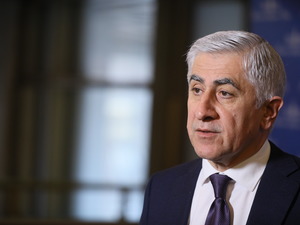Rector of MAI gave a report at the general meeting of the RAS

On November 13-14, 2018, the General Meeting of Members of the Russian Academy of Sciences(RAS) was held in Moscow, within the framework of which priorities of the country's scientific and technological development were considered.
The Strategy for Scientific and Technological Development defines the greatest of challenges facing the country, by which the totality of problems, threats and opportunities, the complexity and scale such that they cannot be solved, eliminated or realized only by increasing resources are understood.
In accordance with the big challenges, seven priority directions of scientific and technological development has been formulated, with the creation of relevant Council for each one of them.
The main task of Council for the priority of scientific and technological revolution is the formation and selection of integrated programs and projects of the complete innovation cycle. Where a simple concentration of resource does not lead to the solution of the problem, we need non-trivial solutions that science must offer and develop comprehensive scientific and technical programs and projects for their implementation.
The Council on Priority “Coherence of the Territory of the Russian Federation” through the creation of intelligent transport and telecommunication systems, as well as occupying and retaining leadership positions in the creation of international transport and logistics systems, the development and use of space and airspace, the oceans, the Arctic and Antarctic” is chaired by the Rector of MAI , Academician of RAS Mikhail Pogosian
At each general meeting of the Russian Academy of Sciences, several reports were presented on each of the priorities, highlighting the most relevant socio-economic and scientific-technical problems, the solution of which should be an effective response to the “big challenges”.
When discussing the priority of “Coherence of the Territory of the Russian Federation”, presentations were made by Mikhail Pogosian, as well as Corresponding Member of the Russian Academy of Sciences, astronaut-pilot, twice Hero of the Soviet Union Vladimir Solovyov; Doctor of Physical and Mathematical Sciences Alexander Lutovinov (Space Research Institute of the Russian Academy of Sciences), academician of the RAS Genady Matishov, etc.
In his report, Mikhail Pogosian noted that the coherence of territories is an effective means of solving two strategic tasks: overcoming internal socio-economic imbalances and strengthening foreign economic and foreign policy positions of Russia.
Mikhail Pogosian spoke about the formation of an integrated science and technology program “Coherence of the Territory”, the concept of which was approved by the Council on priority on October 17, 2018. Listing the main directions of the program, Rector of MAI paid special attention to integrated forecasting and modeling of the development of territories, including the construction of optimal transport models based on modern mathematical algorithms, software products and computing centers. “Communications should be planned as a single complex of geolocation, navigation, transport and logistics schemes, infrastructure and means of transportation of new generations,” - said Mikhail Pogosian
Rector of MAI presented the meeting information on the priority areas of technology development for the implementation of the strategy. He told the audience about new approaches to aerodynamics that can be implemented, for example, through the use of bionic design. Such designs are made by 3D printing from innovative materials.
Speaking about the technological directions of development of the aircraft engine industry, Mikhail Pogosian drew attention to the promising low-noise power plants, in the production of which additive technologies and new materials are also used.
Also in the report of Mikhail Pogosian, prospects for the development of information systems using artificial intelligence and other most relevant IT developments, as well as mathematical modeling as a new design environment for testing aircraft were identified